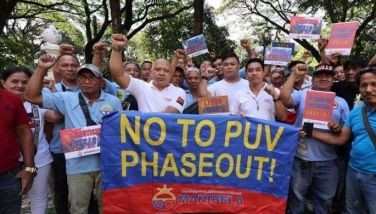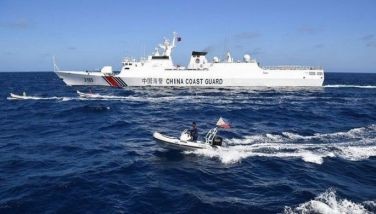DFA chief clarifies US support under Mutual Defense Treaty
MANILA, Philippines - The following is the statement of Foreign Affairs Secretary Albert del Rosario on the Philippines-US Mutual Defense Treaty:
In view of inaccurate information on the subject of whether or not the US is prepared to respond to its commitment to the Philippines under the Philippines-US Mutual Defense Treaty (MDT), the Department of Foreign Affairs would like to establish as a matter of record that:
1. The Philippines and the United States entered into a Mutual Defense Treaty (MDT) on August 30, 1951 in Washington.
2. As stated in the MDT’s preamble, both the Philippines and the US desire to publicly declare, through the MDT, their sense of unity and common determination to defend themselves against external armed attack, so that no potential aggressor could be under the illusion that either of them stands alone in the Pacific Area. (refer to the 3rd paragraph of the MDT’s preamble.)
3. Article IV of the MDT states: “Each Party recognizes that an armed attack in the Pacific area on either of the Parties would be dangerous to its own peace and safety and declares that it would act to meet the common dangers in accordance with its constitutional processes.”
4. Article V of the MDT further provides that “an armed attack on either of the Parties is deemed to include an armed attack on:
a. the metropolitan territory of either of the Parties, or
b. on the island territories under its jurisdiction in the Pacific Ocean, and
c. its armed forces, public vessels or aircraft in the Pacific.”
5. On January 6, 1979, US Secretary of State Cyrus Vance, in his letter to Philippine Foreign Secretary Carlos P. Romulo, cited Article V of the MDT and stated that “… as provided in Article V, an attack on Philippine armed forces, public vessels or aircraft in the Pacific would not have to occur within the metropolitan territory of the Philippines or island territories under its jurisdiction in the Pacific in order to come within the definition of Pacific area in Article V.” (italics supplied).
6. On May 24, 1999, US Ambassador to the Philippines Thomas C. Hubbard wrote a letter to Foreign Secretary Domingo L. Siazon affirming that “the US Government stands by its statements in the Vance-Romulo letter of January 6, 1979.” Moreover, in the same letter, Amb. Hubbard cited Defense Secretary William Cohen’s statement that “the US considers the South China Sea to be part of the Pacific Area.” (italics supplied).
7. On June 23, 2011, Secretary Hillary Clinton reaffirmed to Secretary Albert del Rosario during their meeting in Washington, D.C. that the US “will honor its treaty obligations to the Philippines.”
8. In her remarks to the media after the said meeting, Secretary Clinton declared: “The Philippines and the United States are longstanding allies, and we are committed to honoring our mutual obligation.”
9. During the question and answer session in the same media event, Secretary Clinton was asked by a correspondent from ABS-CBN this question: “What will America do if China attacks Filipino forces in the Spratly Islands?” Secretary Clinton’s reply was: “Well, as to your first question, the United States honors our Mutual Defense Treaty and our strategic alliance with the Philippines. I’m not going to discuss hypothetical events, but I want to underscore our commitment to the defense of the Philippines.” (Source: “Remarks with Philippines Foreign Secretary Albert del Rosario After Their Meeting,” Washington, D.C., June 23, 2011)
10. On November 16, 2011, Secretary Clinton and Secretary del Rosario signed the Manila Declaration which states: “The Republic of the Philippines and the United States today reaffirm our shared obligations under the Mutual Defense Treaty.” (Source: “Manila Declaration on US-Philippine Alliance, 16 November 2011)
11. On April 30, 2012, during the Two Plus Two meeting in Washington, D.C., Secretary Clinton reiterated that the US “reaffirms our commitment and obligations under the mutual defense treaty.” (Source: “Remarks during Press Availability, State Department, Washington, D.C. April 30, 2012)
12. As additional information, under the US Constitution, the US President as Commander-in-Chief may commit US armed forces into action overseas although the US president is obliged to notify the US Congress within 48 hours of such action, as provided for under the US War Powers Resolution of 1973. The same Resolution requires that such commitment of US armed forces could not go beyond 60 days, with a further 30 day withdrawal period, without US congressional authorization. This means that a US congressional authorization is needed only if the engagement of US armed forces abroad would go beyond 60 days.
13. It is important to note that, even in the absence of an actual armed attack against either the Philippines or the US, Article III of the MDT provides that the Philippines and the US, “through their Foreign Ministers or their deputies, will consult together from time to time regarding the implementation of this Treaty and whenever in the opinion of either of them the territorial integrity, political independence or security of either of the Parties is threatened by external armed attack in the Pacific.” (italics supplied).
14. The recently-concluded Two Plus Two meeting, at the Ministerial level, is a new mechanism for such high-level consultations.
- Latest
- Trending






























